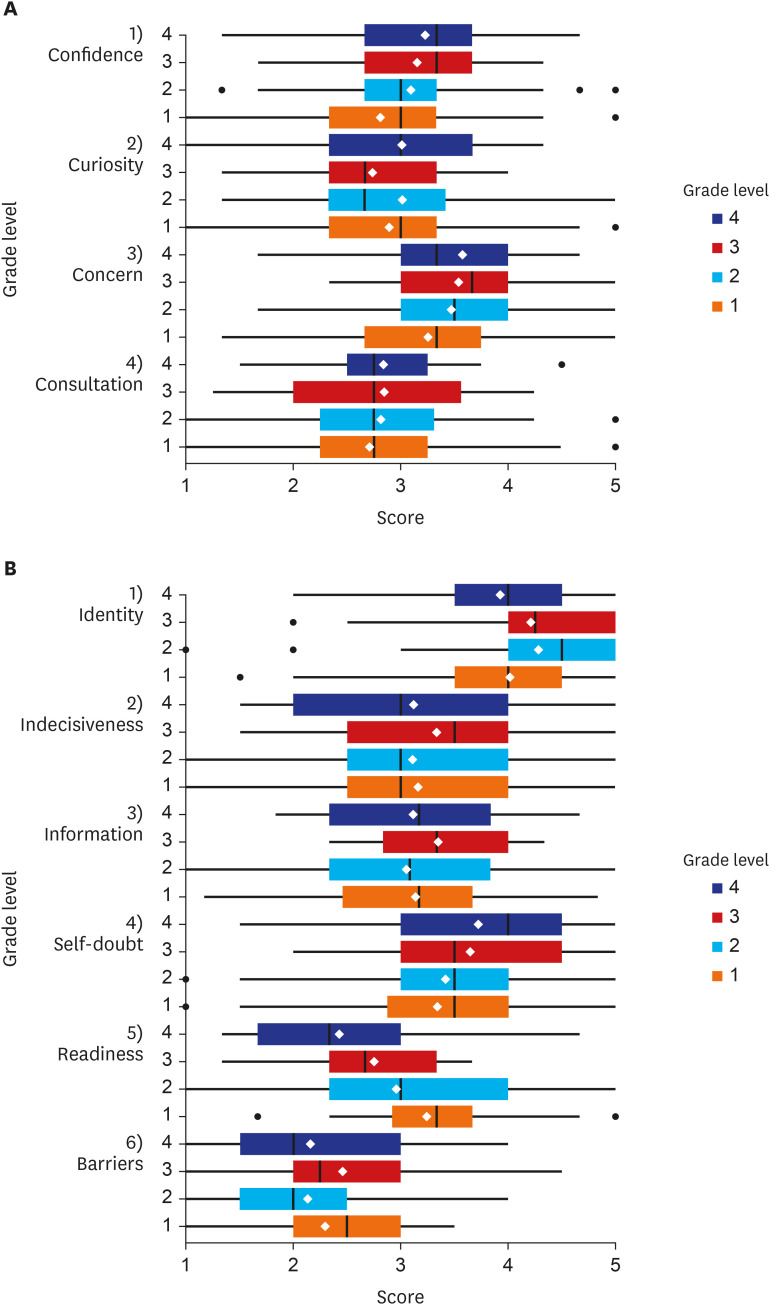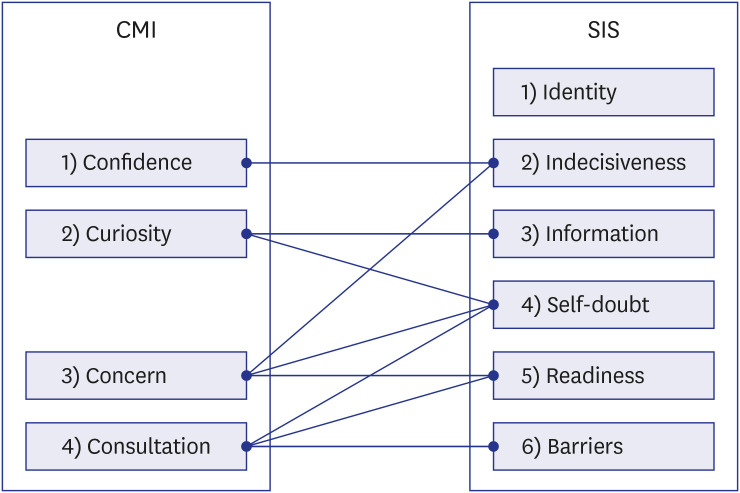J Korean Med Sci.
2022 Sep;37(37):e277. 10.3346/jkms.2022.37.e277.
Analysis on Students’ Career Preparation in One Korean Medical School: Based on the Relationship and Trend Between Career Maturity and Specialty Indecision
- Affiliations
-
- 1Department of Medical Education, Chungnam National University College of Medicine, Daejeon, Korea
- 2Department of Medical Education, Seoul National University College of Medicine, Seoul, Korea
- KMID: 2533556
- DOI: http://doi.org/10.3346/jkms.2022.37.e277
Abstract
- Background
For medical school students, specialty choice after graduation significantly impacts their future doctor life. Several Korean medical schools have made efforts to prepare career development programs. However, career support programs based on the systematic analysis of medical school students’ first to the final year are still lacking. Therefore, this study aims to analyze the students’ career preparation of one medical school in Korea using the Career Maturity Inventory (CMI) and Specialty Indecision Scale (SIS) and to explore the relationship between CMI and SIS variables.
Methods
From December 2020 to July 2021, we conducted an online survey of 600 students in years 1 to 4 at Seoul National University College of Medicine. We analyzed the differences between the years of the students through one-way analysis of variance of the CMI and SIS and the relationship between the two instruments by correlation analysis and multiple regression analysis.
Results
A total of 198 students completed the survey. The average scores of the CMI variables tended to increase as the year of study went up, and the confidence score of the 1st year students was significantly lower than that of the 2nd and 4th year students. Although there was almost no consistent decrease by year in the SIS variables, 3rd and 4th year students showed significantly lower readiness scores than 1st year students. Additionally, we found that the CMI variables mostly had a negative effect on the SIS variables.
Conclusion
There is an increasing tendency for career maturity by year of study in Korean medical school students. However, looking at the SIS results, the career concerns vary among the students. Therefore, medical schools can effectively use the SIS to identify the career concerns of students.
Keyword
Figure
Reference
-
1. Chung SJ, Suh DH, Kim YI. Designing of an education model for career planning in medical schools. Korean J Med Educ. 2001; 25(2):309–315.
Article2. Jeon WT, Yang EB, Lee SH. Guide of Medical Specialty Choice for Medical Student. 2nd ed. Seoul, Korea: Koonja;2014.3. Yoo HH, Park KH, Kim SY, Im SJ. The effectiveness of a career design program for medical students. Korean Med Educ Rev. 2015; 17(3):131–139.
Article4. MoneyToday. “I don't like ○○ even if I give them more scholarships and living expenses”. Updated 2012. Accessed February 1, 2022. https://news.mt.co.kr/mtview.php?no=2012042413565427341 .5. Young Doctor. Intensifying ‘the rich, the poor, the poor’ by medical department… Doctors avoiding essential medical care. Updated 2014. Accessed February 1, 2022. http://www.docdocdoc.co.kr/news/articleView.html?idxno=2017426 .6. An H, Kim E, Hwang J, Lee S. Analysis of medical students’ needs for development of a career guidance program. Korean J Med Educ. 2014; 26(3):209–216. PMID: 25805263.
Article7. Hur Y, Cho AR, Kwon M. Development of a systematic career coaching program for medical students. Korean J Med Educ. 2018; 30(1):41–50. PMID: 29510607.
Article8. Hur Y, Lee K. Vocational interest xlink:types of medical students and its usage in student career counseling program. Korean J Med Educ. 2012; 24(4):309–317. PMID: 25813327.
Article9. Hur Y, Cho AR, Song EJ, Kim S. Evaluation of a systematic career coaching program for medical students in Korea using the Career Readiness Inventory. J Educ Eval Health Prof. 2018; 15:10. PMID: 29665629.
Article10. Heo RJ, Park KH. The differences in career motivation and career maturity according to the career design program of medical students. Asia Pac J Multimed Serv Converg Art Humanit Sociol. 2018; 8(4):375–386.11. Cha MK. Factors Affecting Specialty Choices in Medical School Students [Dissertation]. Seoul, Korea: Kyung Hee University;2011.12. Chun KH, Park YS, Lee YH. Work value, career choice, and specialty indecision based on career adaptability of medical college and graduate school students. Korean Med Educ Rev. 2012; 14(2):69–77.13. Park KH, Yoo HH, Yim J. Medical student perception of physician values in practice by individual characteristics and preferred medical specialty field. Korean J Med Educ. 2014; 26(4):309–319. PMID: 25800238.
Article14. Kim MK, Kang JO. Comparison of career choice motivation and moral reasoning ability between students in baccalaureate and graduate-entry programs. Korean J Med Educ. 2007; 19(2):91–99.
Article15. Leong FT, Chervinko S. Construct validity of career indecision: negative personality traits as predictors of career indecision. J Career Assess. 1996; 4(3):315–329.
Article16. Kim BW, Kim KH. Career decision level and career preparation behavior of the college students. Korean J Couns Psychother. 1997; 9(1):311–333.17. Gati I, Krausz M, Osipow SH. A taxonomy of difficulties in career decision making. Couns Psychol. 1996; 43(4):510–526.
Article18. Burns LW. Gender Differences Among Correlates of Career Indecision. Ann Arbor, MI, USA: ProQuest Dissertations Publishing;1994.19. Naidoo AV. Career Maturity: A Review of Four Decades of Research. Columbus, OH, USA: ERIC Clearinghouse on Adult, Career and Vocational Education;1998.20. Ha EK, Choi WY. The influence of college student’s career maturity on college adjustment -focusing on mediating effect of career indecision-. J Korea Inst Youth Facil Environ. 2018; 16(2):183–191.21. Crites JO, Savickas ML. Career maturity inventory. J Career Assess. 1978; 4(2):131–138.22. Savickas ML, Porfeli EJ. Revision of the career maturity inventory: the adaptability form. J Career Assess. 2011; 19(4):355–374.23. Crites JO. Major contribution career counseling: a review of major approaches. Couns Psychol. 1974; 4(3):3–23.
Article24. Super DE. Vocational Development: A Framework for Research. New York, NY, USA: Bureau of Publications Teachers College Columbia University;1957.25. Walsh WB, Osipow SH. Career preferences, self-concept, and vocational maturity. Res High Educ. 1973; 1(3):287–295.
Article26. Gottfredson LS, Brown VC. Occupational differentiation among white men in the first decade after high school. J Vocat Behav. 1981; 19(3):251–289.
Article27. Cobb B, Yvette Y. An Analysis of the Career Maturity Levels of Intellectually Gifted Adolescents. Hattiesburg, MS, USA: The University of Southern Mississippi;2008.28. Richard GV, Savickas ML, Early L, Calli J, Englert CA, Bono J. Manual for the Specialty Indecision Scale. 2nd ed. Washington, D.C., USA: AAMC;2007.29. Park IJ. The role of affect spin in the relationships between proactive personality, career indecision, and career maturity. Front Psychol. 2015; 6:1754. PMID: 26635665.
Article30. Prideaux LA, Creed PA. Career maturity, career decision-making self-efficacy and career indecision: a review of the accrued evidence. Aust J Career Dev. 2001; 10(3):7–12.
Article31. Cho NG, Park GB. The effect of career maturity on employment anxiety and career indecision in university students of arts major. J Korean Dance. 2015; 11(4):145–163.32. Busacca LA, Taber BJ. The career maturity inventory-revised: a preliminary psychometric investigation. J Career Assess. 2002; 10(4):441–455.
Article33. Bang NM. Cross-Cultural Validation of the Career Maturity Inventory: A Korean Form [Dissertation]. Iowa City, IA, USA: The University of Iowa;2016.34. Koh HJ. A Study on the Effect of Career Counseling on Korean College Students’ Decision Making Styles and on Career Decision Making Status [Dissertation]. Seoul, Korea: Sookmyung Women’s University;1993.35. Koh MN, Park JH. An analysis of the relationships of career search behavior, career decision-making, and levels of ego-identity and self esteem of university students. J Career Educ Res. 2008; 21(3):69–85.36. Ha J, Hong J. Mediating effect of commitment to a career choice in the relation between career preparation behavior and career decision level among university students. Asian J Educ. 2013; 14(1):353–374.
Article37. Super DE, Hall DT. Career development: exploration and planning. Annu Rev Psychol. 1978; 29(1):333–372. PMID: 341784.
Article38. Savickas ML, Alexander DE, Osipow SH, Wolf FM. Measuring specialty indecision among career-decided students. J Vocat Behav. 1985; 27(3):356–367.
- Full Text Links
- Actions
-
Cited
- CITED
-
- Close
- Share
- Similar articles
-
- Effects of Discipline-based Career Course on Nursing Students' Career Search Self-efficacy, Career Preparation Behavior, and Perceptions of Career Barriers
- The Influence of Academic Self-efficacy and Major Satisfaction on Career Attitude Maturity in Nursing Students
- Case Study on a Revised Career Fair at a Medical School Based on the Career Planning Process Model
- Path Analysis of Factors Influencing Career Preparation Behavior of Korean Nursing Students - Based on Social Cognitive Career Theory
- A Systematic Career Advising Model and Strategies for Medical Students



